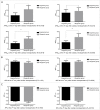Changes in the action potential and transient outward potassium current in cardiomyocytes during acute cardiac rejection in rats
- PMID: 28203415
- PMCID: PMC5303090
- DOI: 10.21037/jtd.2017.01.20
Changes in the action potential and transient outward potassium current in cardiomyocytes during acute cardiac rejection in rats
Abstract
Background: Acute cardiac rejection contributes to the changes in the electrophysiological properties of grafted hearts. However, the electrophysiological changes of cardiomyocytes during acute cardiac rejection are still unknown. An understanding of the electrophysiological mechanisms of cardiomyocytes could improve the diagnosis and treatment of acute cardiac rejection. So it is important to characterize the changes in the action potential (AP) and the transient outward potassium current (Ito ) in cardiomyocytes during acute cardiac rejection.
Methods: Heterotopic heart transplantation was performed in allogeneic [Brown Norway (BN)-to-Lewis] and isogeneic (BN-to-BN) rats. Twenty models were established in each group. Ten recipients were sacrificed at the 2nd day and the other ten recipients were sacrificed at the 4th day after the operation in each group. Histopathological examinations of the grafted hearts were performed in half of the recipients in each group randomly. The other half of the grafted hearts were excised rapidly and enzymatically dissociated to obtain single cardiomyocytes. The AP and Ito current were recorded using the whole cell patch-clamp technique.
Results: Forty grafted hearts were successfully harvested and used in experiments. Histologic examination showed mild rejection at the 2nd day and moderate rejection at the 4th day in the allogeneic group after cardiac transplantation, while no evidence of histologic lesions of rejection were observed in the isogeneic group. Compared with the isogeneic group, the action potential duration (APD) of cardiomyocytes in the allogeneic group was significantly prolonged (APD90 was 49.28±5.621 mV in the isogeneic group and 88.08±6.445 mV in the allogeneic group at the 2nd day, P=0.0016; APD90 was 59.34±5.183 mV in the isogeneic group and 104.0±9.523 mV in the allogeneic group at the 4th day, P=0.0064). The current density of Ito was significantly decreased at the 4th day after cardiac transplantation.
Conclusions: The APD of cardiomyocytes was significantly prolonged during acute cardiac rejection in rats, which might be partly attributed to decreased current densities of Ito .
Keywords: Acute cardiac rejection; action potential (AP); patch-clamp technique; transient outward potassium current.
Conflict of interest statement
Conflicts of Interest: The authors have no conflicts of interest to declare.
Figures





References
-
- Lund LH, Edwards LB, Kucheryavaya AY, et al. The Registry of the International Society for Heart and Lung Transplantation: Thirty-second Official Adult Heart Transplantation Report--2015; Focus Theme: Early Graft Failure. J Heart Lung Transplant 2015;34:1244-54. 10.1016/j.healun.2015.08.003 - DOI - PubMed
-
- Dipchand AI, Rossano JW, Edwards LB, et al. The Registry of the International Society for Heart and Lung Transplantation: Eighteenth Official Pediatric Heart Transplantation Report--2015; Focus Theme: Early Graft Failure. J Heart Lung Transplant 2015;34:1233-43. 10.1016/j.healun.2015.08.002 - DOI - PubMed
-
- Avitall B, Payne DD, Connolly RJ, et al. Heterotopic heart transplantation: electrophysiologic changes during acute rejection. J Heart Transplant 1988;7:176-82. - PubMed
LinkOut - more resources
Full Text Sources
Other Literature Sources
